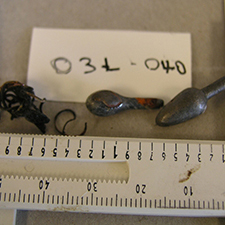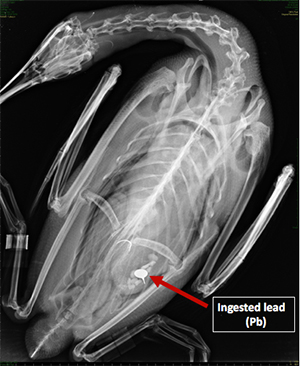This three-year project being led by BRI’s wildlife veterinarians will determine the frequency of lead poisoning in Maine’s Common Loons and help assess the effectiveness of Maine’s new laws limiting the sale and use of certain types of lead fishing gear in fresh water.
Background

In 2002, Maine enacted legislation aimed at protecting loons from lead poisoning, but the law proved too narrow in scope, and significant loon mortalities from lead continued. In an effort to remedy this, a successful bill was introduced to the Maine State Legislature in 2013. The new law strengthens the ban on lead sinkers to include both the sale and use of lead sinkers and includes a larger range of sizes than earlier legislation, banning sinkers weighing up to one ounce. The statute also bans the use and sale of bare lead-headed jigs two-and-a-half inches long or less, with a phased-in ban on the sale of those jigs beginning in September 2016 and on their use beginning in September 2017.
Project Components
1.) Analyze and Expand the Long-term Dataset
For more than 25 years, dead Common Loons from Maine have been examined by Dr. Mark Pokras at Tufts Cummings School of Veterinary Medicine. This long-term dataset gives us a solid basis for comparison as the new legislation takes effect.
2.) Examine Common Loon Cadavers to Determine Cause of Death
Cadavers of Common Loons that die in Maine will be collected for examination. A comprehensive post-mortem (necropsy) examination will then be performed, and any fishing gear present in loons’ digestive tracts will be recovered, measured, and tested for the presence of lead. All recovered lead objects will be carefully documented and saved for future reference. Body fluids and/or tissues will be tested to determine lead levels. Other pathologies or causes of mortality will also be documented.
3.) Assess the Effectiveness of Maine’s New Lead Fishing Gear Regulations
By quantifying new cases of lead poisoning from fishing gear in Common Loons, documenting the specific types of fishing gear that cause lead poisoning, and comparing these new findings to previous data on lead poisoning in loons in Maine over the past 25 years, we can begin to assess the effectiveness of the new legislation, angler compliance with these regulations, and the need for additional law enforcement and/or educational efforts.
Relevant Publications

- Pokras MA, Kneeland MR, Ludi A, Golden E, Major A, Miconi R and Poppenga RH. 2009. Lead objects ingested by common loons in New England. Northeastern Naturalist 16: 177-182.
- Pokras MA, and Kneeland MR. Lead poisoning: Using transdisciplinary approaches to solve an ancient problem. EcoHealth 2008; 5: 379-385
- Sidor IF, Pokras MA, Major AR, Poppenga R and Miconi RM. 2003. Mortality of the common loon in New England 1988-2000. J. of Wildlife Disease 39: 306-315.
- Hanley, C and MA Pokras. 1996. Loons and fishing gear. Maine Sportsman. Hallowell, Maine. (Sept issue).
- Perry C and Pokras MA. 1992. The status of lead poisoning in common loons (Gavia immer) in the Northeastern United States as associated with the ingestion of lead fishing sinkers. U.S. Fish & Wildlife Service Report RY92-NEFO-2-EC. U.S. Fish & Wildlife New England Office. Concord, NH.
- Pokras MA, Press C, and Rohrback S. 1992. The mortality of loons. Massachusetts Wildlife 42: 18-25.
- Pokras MA, Chafel R. and Gibson M. 1991. Environmental pathology of the common loon (Gavia immer) in New England. Trans. Northeast Sect. Wild. Soc. 48: 31-38.
Collaborators and Funders
Collaborators
Funders
BRI wishes to thank Dehler Animal Clinic of Westbrook, Maine, for donating services in support of this project


